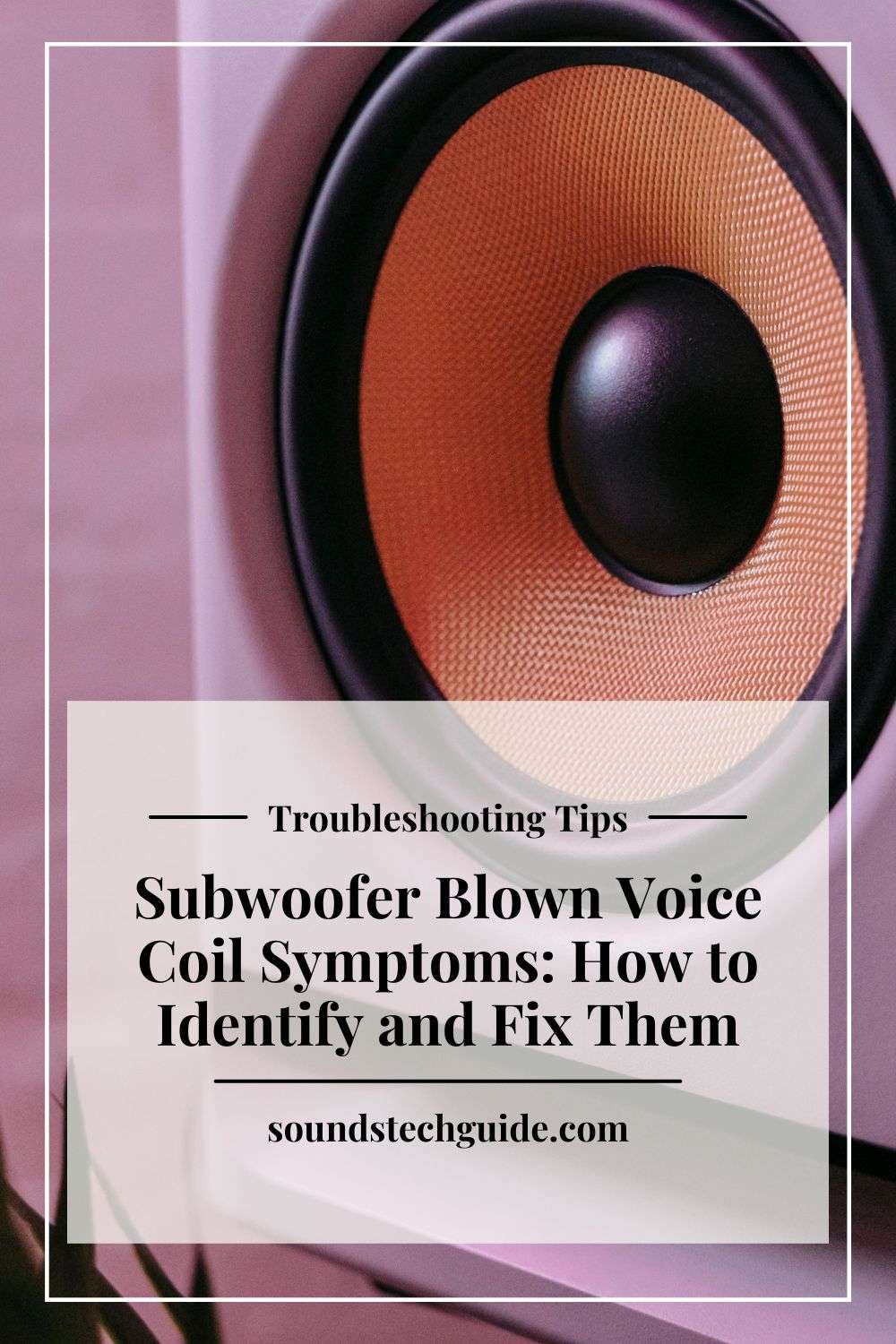A subwoofer is a speaker that produces low-frequency sounds, such as bass and drums. It can enhance your listening experience and make your music or movies more immersive and realistic. However, like any other speaker, a subwoofer can also get damaged or blown due to various reasons. One of the most common problems that can affect a subwoofer is a blown voice coil.
A voice coil is a wire wrapped around a cylinder that moves the speaker cone when an electric current passes through it. The voice coil is one of the most important parts of a subwoofer, as it determines the quality and power of the sound. A blown voice coil can affect the performance of your subwoofer and cause distortion, noise, or no sound at all.
But how do you know if your subwoofer has a blown voice coil? And how do you fix it? In this article, we will show you how to identify and fix subwoofer blown voice coil symptoms. We will also answer some frequently asked questions about this topic. By the end of this article, you will be able to diagnose and repair your subwoofer and enjoy your sound system again.
How to Identify Subwoofer Blown Voice Coil Symptoms
There are several ways to tell if your subwoofer has a blown voice coil. Here are some of the most common symptoms and how to test them:
Distortion
One of the most obvious signs of a blown voice coil is distortion. Distortion is when the sound is unclear, muffled, or distorted. It can also cause crackling, popping, or hissing noises. Distortion can occur at any volume level, but it is more noticeable at higher volumes.
To test for distortion, you can do the following:
- Play some music with bass-heavy content at a low volume level.
- Listen carefully to the sound quality and check for any abnormal noises or lack of bass response.
- Gradually increase the volume level and see if the distortion gets worse or stays the same.
If you hear distortion at any volume level, it means that your subwoofer has a blown voice coil.
Movement
Another sign of a blown voice coil is movement. Movement is when the speaker’s cone does not move properly or at all. It can also cause rattling or scraping sounds. Movement can occur due to two reasons: either the voice coil is stuck or has too much movement.
To test for movement, you can do the following:
- Turn off your amplifier and disconnect your subwoofer from it.
- Carefully remove the grill or cover of your subwoofer and expose the speaker cone.
- Gently push the speaker cone with your finger and see how it moves.
- Compare the movement of your subwoofer with another working one if possible.
If your subwoofer’s cone does not move at all or moves very little, it means that the voice coil is stuck. If your subwoofer’s cone moves too much or makes rattling sounds, it means that the voice coil has too much movement.
Impedance
Another sign of a blown voice coil is impedance. Impedance is the resistance of an electric circuit to an alternating current. It is measured in ohms (Ω). The impedance of a subwoofer depends on its design and specifications. It can range from 2 ohms to 16 ohms or more.
A blown voice coil can affect the impedance of your subwoofer and cause it to be too high or too low. This can cause problems with your amplifier and reduce the sound quality and power of your subwoofer.
To test for impedance, you can do the following:
- Turn off your amplifier and disconnect your subwoofer from it.
- Use a multimeter to measure the impedance of your subwoofer’s voice coil.
- Set the multimeter to ohms (Ω) and touch the probes to the speaker terminals of your subwoofer.
- Read the value on the multimeter’s display and compare it with the rated impedance of your subwoofer.
If your subwoofer’s impedance is too high or too low than its rated impedance, it means that your subwoofer has a blown voice coil.
Damage
Another sign of a blown voice coil is damage. Damage is when there are visible signs of physical damage on your subwoofer’s voice coil or speaker cone. It can be caused by accidents, mishandling, or poor-quality materials. Damage can affect the performance and durability of your subwoofer.
To test for damage, you can do the following:
- Turn off your amplifier and disconnect your subwoofer from it.
- Carefully remove the grill or cover of your subwoofer and expose the speaker cone and voice coil.
- Inspect the speaker cone and voice coil for any signs of damage, such as tears, burns, dents, or corrosion.
If you see any damage on your subwoofer’s speaker cone or voice coil, it means that your subwoofer has a blown voice coil.
How to Fix Subwoofer Blown Voice Coil Symptoms
If you have identified that your subwoofer has a blown voice coil, you have two options: either replace the voice coil or replace the whole subwoofer. Here are some factors to consider before choosing an option:
- The cost of the repair or replacement
- The availability of the parts or the subwoofer
- The difficulty and time of the repair or replacement
- The warranty and guarantee of the parts or the subwoofer
- The compatibility and performance of the parts or the subwoofer
Generally speaking, replacing the voice coil is cheaper and faster than replacing the whole subwoofer. However, it is also more difficult and risky, as it requires soldering skills and precise alignment. Replacing the whole subwoofer is easier and safer, but it is also more expensive and time-consuming. It also requires finding a compatible and high-quality subwoofer.
The best option depends on your personal preference, budget, and skill level. If you are confident and experienced in repairing speakers, you can try to replace the voice coil yourself or hire a professional to do it for you. If you are not comfortable or familiar with repairing speakers, you can buy a new subwoofer or send your old one to a service center for replacement.
FAQs
Here are some frequently asked questions about subwoofer blown voice coil symptoms.
Q: What causes a subwoofer voice coil to blow?
A: There are many possible causes of a subwoofer voice coil to blow, such as:
- Overpowering: This is when you use an amplifier that is too powerful for your subwoofer or set the gain too high. This can cause the voice coil to overheat and melt or burn.
- Underpowering: This is when you use an amplifier that is too weak for your subwoofer or set the gain too low. This can cause the voice coil to clip or distort and damage the wire.
- Poor wiring: This is when you use wires that are too thin, too long, or poorly connected for your subwoofer. This can cause voltage drops, shorts, or sparks that can damage the voice coil.
- Physical impact: This is when you drop, hit, or puncture your subwoofer. This can cause mechanical stress or damage to the voice coil or speaker cone.
Q: How can I prevent my subwoofer voice coil from blowing?
A: There are some preventive measures that you can take to avoid blowing your subwoofer voice coil, such as:
- Matching: This is when you choose an amplifier and a subwoofer that have compatible power ratings and impedance levels. This can ensure optimal performance and safety of your system.
- Setting: This is when you adjust the settings of your amplifier and your subwoofer according to their specifications and recommendations. This can prevent clipping, distortion, or overheating of your system.
- Wiring: This is when you use wires that are thick enough, short enough, and properly connected to your system. This can prevent voltage drops, shorts, or sparks that can damage your system.
- Protecting: This is when you place your subwoofer in a secure and ventilated location. This can prevent physical impact or damage to your system.
Q: Can I use a different voice coil for my subwoofer?
A: No, you cannot use a different voice coil for your subwoofer. The voice coil is designed specifically for your subwoofer’s model and specifications. Using a different voice coil can cause compatibility issues, performance problems, or safety hazards.
Conclusion
A subwoofer-blown voice coil is a common problem that can affect the sound quality and power of your system. You can identify this problem by checking for symptoms such as distortion, movement, impedance, or damage. You can fix this problem by replacing the voice coil or replacing the whole subwoofer.
We hope this article was helpful and informative. If you have any questions or feedback, please let us know in the comments below. And if you liked this article, please share it with your friends and family who might benefit from it. Thank you for reading and happy listening!
You might also like,

